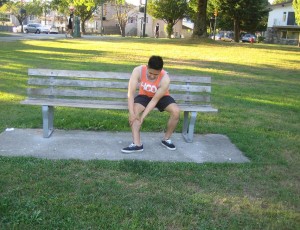Achilles tendon rupture is usually caused by sudden force placed on the foot or ankle. Once ruptured, the individual could no longer stand on the toes or end up with a flat-foot gait. It is vital to seek immediate treatment to promote early healing.
The tear might be incomplete or full. For an incomplete tear, the affected tendon is partially ripped but still connected to the calf muscle. As for a complete tear, the tendon is fully ripped.
What are the possible causes?
- The Achilles tendon can be damaged if there is significant force or stress placed on it. This occurs during activities that involves a forceful push off using the foot such as in running, tennis or basketball.
- The tendon is also damaged in injuries particularly during falls. When the foot is abruptly driven into an upward pointed position, it overly stretches the tendon.
- Sustaining a deep cut or wound at the back of the ankle that involves the tendon.
- If the tendon is weak, it is susceptible to rupture.

Sustaining a deep cut or wound at the back of the ankle that involves the tendon can lead to ankle tendon rupture.
Indications of Achilles tendon rupture
The signs and symptoms occur abruptly during activity. The individual might hear a snap or sudden piercing pain if the tendon is torn. This sharp pain typically settles rapidly, but there is still aching at the back part of the lower leg. After the injury, the typical symptoms include the following:
- Flat-footed walk – the individual can walk and bear weight but could not push off the ground properly on the side where the tendon is damaged
- Difficulty standing on tiptoe
- If the tendon is fully torn, a gap is felt right above the back part of the heel. If bruising and swelling are present, it might conceal this gap.
Management
The injury must be diagnosed and managed as soon as possible since immediate treatment ensures proper recovery. If Achilles tendon rupture is suspected, the individual should not place any weight on the foot.
Conservative treatment
The tendon can heal naturally usually in a brace or plaster cast. If the tendon could not recuperate on its own, surgery is performed later.
Surgery
If surgery is performed, the surgeon sews together the ripped edges of the tendon and might even utilize another tendon or a tendon graft for the repair. A brace or plaster cast is also required after the procedure.
It is important to note that both options involve the placement of a brace or plaster cast for about 8 weeks to protect the tendon as it heals. The brace or plaster cast is positioned so that the foot is pointed slightly downwards which reduces the strain from the tendon.
Customarily, crutches are used to keep weight off the leg during the initial weeks of treatment. At the present, using the leg normally early is observed. This involves fitting of a plaster cast or brace that the individual can walk on.
Quick Note / Disclaimer
The material posted on this page on Achilles tendon rupture is for learning and educational purposes only. To learn to recognize and manage tendon injuries including a ruptured Achilles tendon, register for a first aid and CPR course with Saskatoon First Aid.

